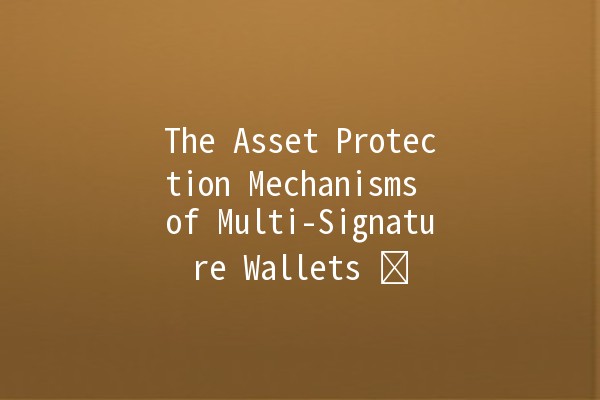




In the evolving landscape of digital finance and cryptocurrency, securing assets is paramount. Multisignature wallets (or multisig wallets) have emerged as a robust solution to enhance asset protection. Unlike traditional wallets, multisig wallets require multiple private keys to authorize a transaction, thereby providing an additional layer of security that can significantly reduce the risk of theft, fraud, or loss.

A multisignature wallet is a digital wallet that requires more than one private key to authorize a cryptocurrency transaction. This means that multiple parties must approve a transaction before it can be executed. For example, a 2of3 multisig setup means that three keys exist, and at least two must provide their signatures for a transaction to proceed. This mechanism is particularly beneficial for shared accounts among multiple users, such as businesses or joint ventures.
Clearly define who holds which private keys and the authority each party has. Establishing specific roles ensures everyone knows their responsibilities in transactions and maintenance. For instance, in a business setting, the CFO could hold one key, while the CTO holds another, with a third key held by a trusted advisor.
Set thresholds for transaction amounts that require different levels of approval. For smaller transactions, a 1of2 signoff might be sufficient, while larger amounts can necessitate a 2of3 or higher approval level. This tiered approach can streamline operations while maintaining security.
Conduct regular audits of your multisig wallet setup to ensure no vulnerabilities exist. Check for the integrity of the keys, review the approval process, and assess the security of physical devices storing keys. This proactive measure can prevent potential breaches.
Integrate Hardware Security Modules for key storage. HSMs provide physical and logical protection for sensitive cryptographic keys, ensuring they are less susceptible to online threats or physical theft. For example, a company could store its multisig keys across several HSMs located in different geographical locations.
Ensure all parties involved are educated about security practices and the functioning of multisignature wallets. Regular training sessions can help refresh knowledge and adapt to new threats, reinforcing the importance of security among all key holders.
Multisignature wallets employ several mechanisms to enhance asset security. By understanding these, users can appreciate the vital role multisig technology plays in safeguarding their assets.
This mechanism lowers individual risk by decentralizing access. Since several keys are dispersed among trusted parties, it eliminates the risk linked to relying on a single individual or entity to manage funds. For instance, if a company's CFO has a key and is unavailable, the other key holders could still access the funds.
Many multisig wallets utilize tamperproof technology that alerts users if an unauthorized attempt is made to access the wallet. This feature acts proactively to enable quick responses to potential threats.
Some multisignature wallets allow users to set time locks on transactions. This means that even if all signatures are obtained, a transaction cannot be executed before a predetermined period. This feature is particularly useful for large transfers, allowing for additional time to reassess the transaction.
Integrating multifactor authentication mechanisms adds another layer of security. Users are required to provide additional verification (like OTPs or biometric data) alongside their signatures, ensuring only authorized individuals can execute transactions.
Many multisignature wallets come with builtin alert systems notifying key holders of any attempted or completed transactions. This feature ensures that all stakeholders stay informed about activities, further enhancing accountability and trust within the group.
A startup can use a 2of3 multisig wallet where the cofounders and a legal advisor hold keys. This ensures that funds cannot be accessed without consensus, minimizing the risk of unilateral decisions which could endanger company assets.
For families managing a trust fund, using a 3of5 multisig wallet where each family member holds a key, and two outside advisors hold the other keys, can help maintain asset security and ensure joint decisions on fund usage.
Some exchanges employ multisig technology to protect user funds. By holding user deposits in multisig wallets, exchanges can better protect against potential breaches while providing users with peace of mind regarding the safety of their assets.
If one key is lost in a multisignature wallet, the remaining keys can still be used to authorize transactions. As long as the required threshold of signatures is met, access to the wallet remains intact.
Yes, many services now offer userfriendly interfaces for setting up multisignature wallets. While some understanding of the underlying principles helps, several platforms provide stepbystep guidance.
In the event that a key holder becomes untrustworthy, the remaining parties can adjust their agreement or set up a new multisignature wallet with different trusted parties, provided that the original wallet structure allows for such changes without losing access.
While multisignature wallets significantly reduce risk, they are not immune to hacking. Cybersecurity remains essential; therefore, users must adopt comprehensive security measures, including regularly updating their software and employing strong password practices.
Various platforms, including hardware wallets like Trezor and Ledger, software wallets like BitGo and Electrum, and numerous cryptocurrency exchanges, support multisignature wallets. It’s crucial to choose a reputable platform known for its security features.
For businesses, multisignature wallets offer enhanced security and collaborative asset management. Every financial decision often requires consensus, minimizing the risk of fraud and ensuring better oversight of company funds.
The efficacy of multisignature wallets is undeniable as digital currency becomes an increasingly popular asset class. By utilizing the principles of shared responsibility, decentralized control, and robust security mechanisms, multisignature wallets serve as a reliable option for individuals and organizations seeking to protect their digital assets efficiently. These wallets not only fortify against breaches but also take a significant stride towards responsible financial management in the digital era.